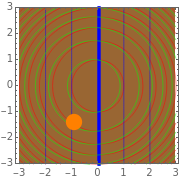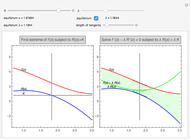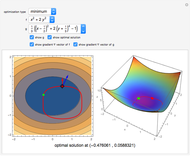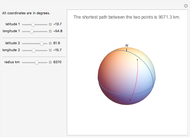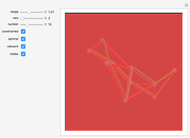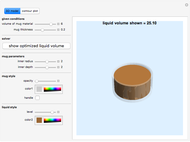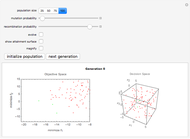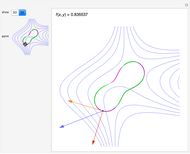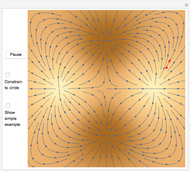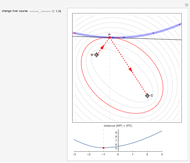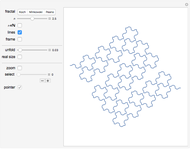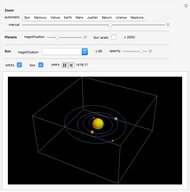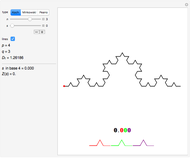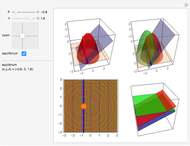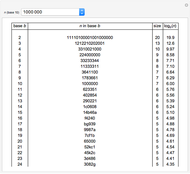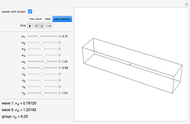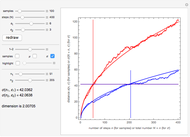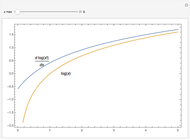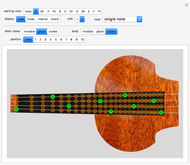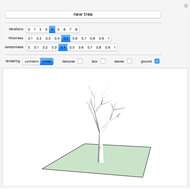Lagrange Multipliers in Two Dimensions

Requires a Wolfram Notebook System
Interact on desktop, mobile and cloud with the free Wolfram Player or other Wolfram Language products.
This Demonstration intends to show how Lagrange multipliers work in two dimensions.
[more]
Contributed by: Cedric Voisin (July 2012)
Open content licensed under CC BY-NC-SA
Snapshots
Details
The function  (plotted in red) is the one to be optimized subject to the constraint. Here
(plotted in red) is the one to be optimized subject to the constraint. Here  . The function
. The function  is the constraint function, plotted in blue. The constraint is its particular contour line
is the constraint function, plotted in blue. The constraint is its particular contour line  . Here
. Here  , so the constraint is
, so the constraint is  , which is simpler to visualize (thick blue line). In this particular case, the new potential
, which is simpler to visualize (thick blue line). In this particular case, the new potential  is a Legendre transformation, where
is a Legendre transformation, where  (given the constraint
(given the constraint  ). Hence, as
). Hence, as  , for obvious symmetry reasons the complete solution here is quite simple:
, for obvious symmetry reasons the complete solution here is quite simple:  . The function
. The function  (plotted in green) is the difference in height between
(plotted in green) is the difference in height between  and the rescaled constraint function
and the rescaled constraint function  , which is constant only when
, which is constant only when  and
and  are parallel. The equilibrium condition
are parallel. The equilibrium condition  (
( ) can be seen as a constraint on
) can be seen as a constraint on  .
.
The main ideas behind the Lagrange multipliers have already been discussed in the 1D case. See Lagrange Multipliers in One Dimension.
This Demonstration illustrates the 2D case, where in particular, the Lagrange multiplier  is shown to modify not only the relative slopes of the function
is shown to modify not only the relative slopes of the function  to be minimized and the rescaled constraint
to be minimized and the rescaled constraint  (which was already shown in the 1D case), but also their relative orientations (which do not exist in the 1D case).
(which was already shown in the 1D case), but also their relative orientations (which do not exist in the 1D case).
This in turn shows how the independence of  and
and  is restored by the introduction of
is restored by the introduction of  (which is adjusted so that
(which is adjusted so that  and
and  are strictly parallel in both slope and orientation, so that their height difference
are strictly parallel in both slope and orientation, so that their height difference  remains constant near the solution, with no more constraint between
remains constant near the solution, with no more constraint between  and
and  ).
).
The global problem can be understood as finding a point that is:
1. on the particular contour line  , and
, and
2. on a contour line  or
or  (the constant is unknown, as the contour line is what we are looking for) tangent to the previous one.
(the constant is unknown, as the contour line is what we are looking for) tangent to the previous one.
By imposing  (for any
(for any  ), we impose that
), we impose that  and
and  share the same orientation but with different relative slopes (depending on
share the same orientation but with different relative slopes (depending on  ).
).
 is then a tuning tool to find the place where the functions
is then a tuning tool to find the place where the functions  and
and  have the same slope (strict parallelism) and hence where the potential
have the same slope (strict parallelism) and hence where the potential  is an extremum (equilibrium situation).
is an extremum (equilibrium situation).
Here are a few explanations for each of the four plots displayed:
• upper-left: this is the case treated without the Lagrange multiplier. The thick blue line is the constraint, the thick red line is its projection on  , and the solution is the top of the red thick line.
, and the solution is the top of the red thick line.
• upper-right: this is the case treated with the help of  . The constraint function
. The constraint function  is rescaled (
is rescaled ( ), but as
), but as  , the constraint (thick blue line) keeps the same position as in the previous case. The function
, the constraint (thick blue line) keeps the same position as in the previous case. The function  plotted in green is the new potential, which is to be optimized without constraint on
plotted in green is the new potential, which is to be optimized without constraint on  . When equilibrium is forced, its extremum corresponds to the solution of the problem. When equilibrium is not forced, it is a function of the three variables
. When equilibrium is forced, its extremum corresponds to the solution of the problem. When equilibrium is not forced, it is a function of the three variables  ,
,  ,
,  .
.
• bottom-left: same as upper-right, but with a contour representation, which shows more clearly the contour lines and the extremums of the three functions involved. The orange point is the one given by the 2D slider. When equilibrium is forced, it shows the solution of the problem (top of the green function  ); otherwise it can be used to explore the slopes with the bottom-right panel.
); otherwise it can be used to explore the slopes with the bottom-right panel.
• bottom-right: this is a close-up (tangent planes) of the plots of the three functions involved around the position (orange point) chosen by the 2D slider. It allows a comparison between their slopes. In particular, when  ,
,  and
and  have the same orientation but different slopes (this amounts to the 1D problem), and near the solution, they become completely parallel. When
have the same orientation but different slopes (this amounts to the 1D problem), and near the solution, they become completely parallel. When  , their orientations are different. When equilibrium is forced, their slopes remain parallel, hence
, their orientations are different. When equilibrium is forced, their slopes remain parallel, hence  remains horizontal (constant).
remains horizontal (constant).
When forcing equilibrium, you can only change  (then
(then  ,
,  , and
, and  are the computed unique solution of the problem).
are the computed unique solution of the problem).
With the equilibrium box unchecked, you can change  (a slider) and
(a slider) and  (2D slider) to get a feeling of how they act and what they mean.
(2D slider) to get a feeling of how they act and what they mean.
Permanent Citation
